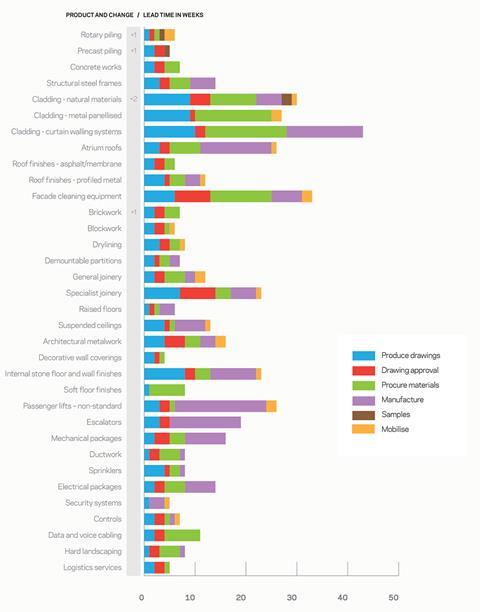Most works packages continue to be unmoved, but increased activity means that some rises are expected in the months ahead. Brian Moone of Mace Business School summarises the data
01 / GOING UP
▲Rotary piling
▲Precast piling
▲Cladding - natural materials
▲B��������ɴǰ���
02 STAYING LEVEL
▶Concrete works
▶Structural steel frames
▶Metal panellised cladding
▶Curtain walling
▶Atrium roofs
▶Asphalt/membrane roof finishes
▶Profiled metal roof finishes
▶Facade cleaning equipment
▶B��������ɴǰ���
▶B���dz���ɴǰ���
▶D��������Ծ��Բ�
▶Metal doors
▶Demountable partitions
▶General joinery
▶Specialist joinery
▶Raised floors
▶Suspended ceilings
▶Architectural metalwork
▶Decorative wall coverings
▶Internal stone floor and wall finishes
▶Soft floor finishes
▶Non-standard passenger lifts
▶E�����������ٴǰ���
▶Electrical packages
▶Mechanical packages
▶D�ܳ��ٷɴǰ���
▶S�������������
▶Security systems
▶C�DzԳٰ��DZ���
▶IT infrastructure equipment
▶Logistics services
▶Hard landscaping
03 / LEAD TIMES SUMMARY
Lead times for rotary piling ▲ continue to fluctuate, with an increase this quarter of one week to six weeks due to an increase in site mobilisation. Precast piling ▲ has also increased by one week to five weeks.
Concrete works ▶ remain at seven weeks following the reduction last quarter. Contractors are reporting that they are busier than six months ago and enquiries have increased.
Structural steel frames ▶ stay at 14 weeks.
No change is anticipated in the next six months despite being busier with enquiries.
Cladding - natural materials ▲ have increased by two weeks to 30 weeks as a result of increases in workload. Metal panellised cladding systems ▶ have remained at 27 weeks since Q1 2010 and no change is forecast. Curtain walling systems ▶ have been at 43 weeks since the beginning of 2012 with no change forecast.
Atrium roofs ▶ stay at 26 weeks, with no changes forecast in the next six months. Asphalt/membrane roof finishes ▶ remain at seven weeks for the second quarter. Profiled metal roof finishes ▶ have been at 12 weeks since mid-2009 with no change forecast.
Facade cleaning equipment ▶ stays at 33 weeks, but companies are currently busy and enquiries have picked up.
Brickwork ▲ has increased by one week for the second consecutive quarter to six weeks.
Blockwork ▶ remains at six weeks. However, with increased workload and enquiries, companies are forecasting longer lead times in the next six months.
Drylining ▶ is stable at eight weeks, with no changes forecast. Demountable partitions ▶ remain at seven weeks. General joinery ▶ stays at 12 weeks with no change forecast in the next six months. Specialist joinery ▶ remains at 23 weeks.
Raised floors ▶ remain at six weeks. Contractors’ enquiries and workload have increased but no change is forecast for the next six months.
Architectural metalwork ▶ remains at 16 weeks, but enquiries and workload are rising.
Decorative wall coverings ▶ stay at four weeks, with no change anticipated. Internal stone floor and wall finishes ▶ remain at 24 weeks. Increases are anticipated in the next six months due to increased activity in the market. Soft floor finishes ▶ have remained at eight weeks since the end of 2010.
Passenger lifts - non-standard ▶ remain at 26 weeks - workload and enquiries remain unchanged, with no change in forecast. Escalators ▶ stay at 19 weeks, with no change forecast for the next six months.
Electrical packages ▶ have been at 14 weeks since mid-2009, but are anticipated to increase in the next six months.
Mechanical packages ▶ remain at 16 weeks, but contractors are anticipating an increase in the next quarter.
Ductwork and sprinklers ▶ both stay at eight weeks, with no change forecast for the next six months.Security systems ▶ have been at five weeks for over two years, but with enquiries and workload up this is anticipated to increase in the next six months. Controls ▶ remain at seven weeks, with no change forecast.
IT infrastructure equipment ▶ stays at six weeks despite being busier due to improved availability of equipment. Longer lead times are anticipated in the next six months. Data and voice cabling ▶ remains at 11 weeks but is expected to increase in the next six months.
Hard landscaping ▶ remains at eight weeks, with no change forecast. Contractors are busier now than in the past six months and forecast that this will continue.
Logistics services ▶ remain at five weeks, with no change forecast in the next six months.
For the second quarter running there are signs that workload and enquiries are on the increase across many specialist trades. These increases are resulting in longer lead times for four trades: rotary piling, pre-cast piling, cladding and brickwork. However, eight other trades are anticipating that lead times will increase in the next six months.
The brick and block industries continue to report shortages, compounded by longer lead-in from haulage contractors delaying deliveries.
Data capture and analysis by Mace Business School. For more details on the article and contributors, please visit

Downloads
Lead times
PDF, Size 0 kb
























No comments yet